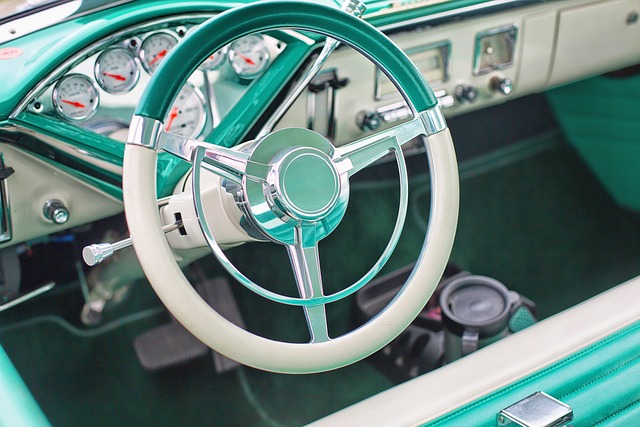Looking to register your car in California? Navigating the process can seem daunting, but with the right preparation, it’s seamless. This guide breaks down the steps involved, from gathering essential documents like proof of insurance and ownership, to using a VIN verifier to confirm your vehicle’s identity. We’ll walk you through choosing a DMV location, completing registration forms, and ensuring a smooth transition for your California-registered vehicle.
- Understanding the Registration Process
- Gather Necessary Documents
- Verify the Vehicle's VIN (Vehicle Identification Number)
- Choose a California DMV Location
- Complete the Registration and Title Transfer
Understanding the Registration Process

Understanding the Registration Process in California
Registering a car in California involves several steps that can seem intricate but are designed to ensure vehicle safety and security. The process begins with gathering essential documents, including proof of ownership through a Vehicle Identification Number (VIN) verifier or mobile VIN verification, valid identification, and any necessary fees. It’s crucial to verify your vehicle’s VIN during this phase as it uniquely identifies your car and is critical for record-keeping and security purposes.
A key component of the registration process is ensuring that your vehicle meets safety standards through inspections. This can include a traditional vin inspection at a designated location or, in some cases, opting for a mobile vin inspection service that comes to you. These checks verify that your car’s lights, brakes, tires, and other critical systems are in proper working order before granting official registration.
Gather Necessary Documents

Before you start the registration process, make sure you have all the essential documents ready. The California Department of Motor Vehicles (DMV) requires a range of paperwork to ensure a smooth and legitimate transaction. Firstly, you’ll need your Vehicle Identification Number (VIN) verifier or what’s commonly known as a mobile vin verifier. This tool is crucial for confirming ownership and vehicle details during the registration process. Many services now offer convenient mobile vin inspection, making it easy to verify your car’s information before heading to the DMV.
Additionally, prepare other necessary documents such as proof of insurance, a bill of sale or purchase agreement, and a valid driver’s license. The DMV might also request other forms depending on how you intend to register your vehicle—whether it’s new or used. Having these documents readily available will save you time and potential hassle during the registration process.
Verify the Vehicle's VIN (Vehicle Identification Number)

Before you begin the registration process, it’s crucial to verify your vehicle’s VIN (Vehicle Identification Number). This unique 17-character code is a critical component in identifying your car and ensuring its authenticity. You can easily confirm the VIN using a reliable mobile vin verifier or mobile vin inspection app, which allows you to quickly and accurately read the number from your vehicle’s label.
Accessing this information is an essential step as it helps to prevent fraud and ensures that you’re providing accurate data when registering your car with the California Department of Motor Vehicles (DMV). With just a few taps on your smartphone, you can input the VIN into the app, which will then cross-reference it against global databases, delivering immediate results for a stress-free registration experience.
Choose a California DMV Location

When registering your car in California, the first step is to select a convenient California Department of Motor Vehicles (DMV) location. The DMV offers several options for car registration, including in-person visits and various mobile services. For those who prefer a more flexible approach, scheduling a visit to one of their numerous field offices or choosing a mobile vin inspection service could be the way to go. These services allow you to conduct essential procedures like VIN (Vehicle Identification Number) verification right at your convenience.
Choosing a location that provides both traditional and modern registration options ensures a smoother process. The DMV’s online tools, coupled with their physical locations, enable Californians to register their vehicles efficiently. Whether you opt for an in-person visit or leverage mobile vin inspection services, having the correct VIN data readily available will significantly facilitate the car registration process in California.
Complete the Registration and Title Transfer

After gathering all necessary documents, it’s time to complete the registration and title transfer process. This involves submitting your application to the California Department of Motor Vehicles (DMV). Make sure to include the original title and a completed Form MV-5, which is the Application for Title and Registration. Don’t forget to provide proof of insurance and vehicle identification number (VIN) verification. The VIN verifier ensures the accuracy of your vehicle’s information, which is crucial for a successful registration.
For convenience, many people opt for mobile VIN inspection services that come to their location. This is particularly useful if you’re short on time or have a busy schedule. With just a few details from your vehicle, such as the VIN, these services can provide the necessary verification, making the registration process smoother and faster.
Registering your car in California involves understanding the process, gathering essential documents, verifying the Vehicle Identification Number (VIN) using a reliable VIN verifier, choosing the nearest Department of Motor Vehicles (DMV) location, and completing the registration and title transfer. By following these steps and ensuring all information is accurate, you’ll have a smoothly registered vehicle in no time.
